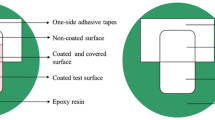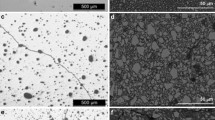Abstract
Objectives
The objective of the study was to investigate the relationship between pH-neutralization, hydrophilicity, and free hygroscopic expansion stress of self-adhesive resin cements (SARCs) after storage in artificial saliva.
Materials and methods
The SARCs RelyX Unicem Automix 2 (RX2, 3 M ESPE), iCEM (iCEM, Heraeus) and Maxcem Elite (MCE, Kerr) were under investigation in this study. Cylinders (height × diameter, 6 × 4mm) were prepared from each material and stored in artificial saliva (7d at 37 °C). Cylinder height was measured at baseline and after 7 days. After storage, the compression modulus was measured to calculate the free hygroscopic expansion stress. For pH-neutralization and hydrophilicity assessment, disks (height × diameter, 1 × 1.5 mm) were prepared, covered with electrolyte, and monitored over 24 h at 37 °C. Hydrophilicity was assessed using the static sessile drop technique at baseline and at different time intervals up to 24 h. Data were analyzed using one-way ANOVA and post hoc Student-Newman-Keuls test (S-N-K, α = 0.05).
Results
After 24 h, RX2 (pH24h 4.68) had a significantly higher (p < 0.05) pH-value than MCE (pH24h 4.2) and iCEM (pH24h 3.23). iCEM showed the significantly highest hydrophilicity (p < 0.05) after 24 h (θ24h 85.02°), while MCE resulted lower (θ24h 113.01°) in comparison with RX2 (θ24h 108.11°). The resulting hygroscopic expansion stress of iCEM (29.15 MPa) was significantly higher (p < 0.05) compared to RX2 (14.5 MPa) and MCE (21.02 MPa).
Conclusions
The material with lowest pH-neutralization capacity displayed higher hydrophilicity after 24 h and higher hygroscopic expansion stress after 7 days compared to those with high pH-neutralization.
Clinical significance
Remnant hydrophilicity due to low pH-neutralization of SARCs could lead to cement interface stress build-up and long-term failure of silicate ceramic restorations.


Similar content being viewed by others
References
Ferracane JL, Stansbury JW, Burke FJ (2011) Self-adhesive resin cements—chemistry, properties and clinical considerations. J Oral Rehabil 38:295–314
Monticelli F, Osorio R, Mazzitelli C, Ferrari M, Toledano M (2008) Limited decalcification/diffusion of self-adhesive cements into dentin. J Dent Res 87:974–979
Gerth HU, Dammaschke T, Zuchner H, Schafer E (2006) Chemical analysis and bonding reaction of Rely X Unicem and Bifix composites—a comparative study. Dent Mater 22:934–941
Madruga FC, Ogliari FA, Ramos TS, Bueno M, Moraes RR (2013) Calcium hydroxide, pH-neutralization and formulation of model self-adhesive resin cements. Dent Mater 29:413–418
Zorzin J, Petschelt A, Ebert J, Lohbauer U (2012) pH neutralization and influence on mechanical strength in self-adhesive resin luting agents. Dent Mater 28:672–679
Saskalauskaite E, Tam LE, McComb D (2008) Flexural strength, elastic modulus, and pH profile of self-etch resin luting cements. J Prosthodont 17:262–268
Vrochari AD, Eliades G, Hellwig E, Wrbas KT (2009) Curing efficiency of four self-etching, self-adhesive resin cements. Dent Mater 25:1104–1108
Vrochari AD, Eliades G, Hellwig E, Wrbas KT (2010) Water sorption and solubility of four self-etching, self-adhesive resin luting agents. J Adhes Dent 12:39–43
Li J, Li H, Fok AS, Watts DC (2009) Multiple correlations of material parameters of light-cured dental composites. Dent Mater 25:829–836
Costa LA, Carneiro KK, Tanaka A, Lima DM, Bauer J (2014) Evaluation of pH, ultimate tensile strength, and micro-shear bond strength of two self-adhesive resin cements. Braz Oral Res 28:1–7
Park JW, Ferracane JL (2014) Water aging reverses residual stresses in hydrophilic dental composites. J Dent Res 93:195–200
Belli R, Pelka M, Petschelt A, Lohbauer U (2009) In vitro wear gap formation of self-adhesive resin cements: a CLSM evaluation. J Dent 37:984–993
Ferracane JL (2006) Hygroscopic and hydrolytic effects in dental polymer networks. Dent Mater 22:211–222
McCabe JF, Rusby S (2004) Water absorption, dimensional change and radial pressure in resin matrix dental restorative materials. Biomaterials 25:4001–4007
Versluis A, Tantbirojn D, Lee MS, LS T, DeLong R (2011) Can hygroscopic expansion compensate polymerization shrinkage? Part I. Deformation of restored teeth. Dent Mater 27:126–133
Chutinan S, Platt JA, Cochran MA, Moore BK (2004) Volumetric dimensional change of six direct core materials. Dent Mater 20:345–351
Leevailoj C, Platt JA, Cochran MA, Moore BK (1998) In vitro study of fracture incidence and compressive fracture load of all-ceramic crowns cemented with resin-modified glass ionomer and other luting agents. J Prosthet Dent 80:699–707
Sindel J, Frankenberger R, Kramer N, Petschelt A (1999) Crack formation of all-ceramic crowns dependent on different core build-up and luting materials. J Dent 27:175–181
Sterzenbach G, Karajouli G, Tunjan R, Spintig T, Bitter K, Naumann M (2015) Damage of lithium-disilicate all-ceramic restorations by an experimental self-adhesive resin cement used as core build-ups. Clin Oral Investig 19:281–288
Taschner M, Nato F, Mazzoni A, Frankenberger R, Falconi M, Petschelt A, Breschi L (2012) Influence of preliminary etching on the stability of bonds created by one-step self-etch bonding systems. Eur J Oral Sci 120:239–248
Han L, Okamoto A, Fukushima M, Okiji T (2007) Evaluation of physical properties and surface degradation of self-adhesive resin cements. Dent Mater J 26:906–914
Marghalani HY (2012) Sorption and solubility characteristics of self-adhesive resin cements. Dent Mater 28:e187–e198
Ping ZH, Nguyen QT, Chen SM, Zhou JQ, Ding YD (2001) States of water in different hydrophilic polymers - DSC and FTIR studies. Polymer 42:8461–8467
Yiu CK, King NM, Carrilho MR, Sauro S, Rueggeberg FA, Prati C, Carvalho RM, Pashley DH, Tay FR (2006) Effect of resin hydrophilicity and temperature on water sorption of dental adhesive resins. Biomaterials 27:1695–1703
Nomoto R, Komoriyama M, McCabe JF, Hirano S (2004) Effect of mixing method on the porosity of encapsulated glass ionomer cement. Dent Mater 20:972–978
Boaro LC, Goncalves F, Guimaraes TC, Ferracane JL, Pfeifer CS, Braga RR (2013) Sorption, solubility, shrinkage and mechanical properties of "low-shrinkage" commercial resin composites. Dent Mater 29:398–404
da Silva EM, Poskus LT, Guimaraes JG (2008) Influence of light-polymerization modes on the degree of conversion and mechanical properties of resin composites: a comparative analysis between a hybrid and a nanofilled composite. Oper Dent 33:287–293
Adusei G, Deb S, Nicholson JW, Mou L, Singh G (2003) Polymerization behavior of an organophosphorus monomer for use in dental restorative materials. J Appl Polym Sci 88:565–569
Wei YJ, Silikas N, Zhang ZT, Watts DC (2011) Hygroscopic dimensional changes of self-adhering and new resin-matrix composites during water sorption/desorption cycles. Dent Mater 27:259–266
Alrahlah A, Silikas N, Watts DC (2014) Hygroscopic expansion kinetics of dental resin-composites. Dent Mater 30:143–148
Sideridou ID, Karabela MM, Vouvoudi E (2008) Volumetric dimensional changes of dental light-cured dimethacrylate resins after sorption of water or ethanol. Dent Mater 24:1131–1136
Martin N, Jedynakiewicz NM, Fisher AC (2003) Hygroscopic expansion and solubility of composite restoratives. Dent Mater 19:77–86
ISO (2009) 4049:2009 Dentistry - Polymer-based restorative materials. International Organization for Standardization, Geneva
Lohbauer U (2009) Dental glass ionomer cements as permanent filling materials? – properties, limitations and future trends. Materials 3:76–96
Mese A, Burrow MF, Tyas MJ (2008) Sorption and solubility of luting cements in different solutions. Dent Mater J 27:702–709
Acknowledgments
The present work was performed by Ms. Lena Rödel in fulfillment of the requirements for obtaining the degree “Dr. med. dent..”
Author information
Authors and Affiliations
Corresponding author
Ethics declarations
Conflict of interest
The authors declare that they have no conflict of interest.
Funding
The work was supported by Dental Clinic 1—Operative Dentistry and Periodontology of the Friedrich-Alexander University Erlangen-Nürnberg.
Ethical approval
This article does not contain any studies with human participants or animals performed by any of the authors.
Informed consent
For this type of study, formal consent is not required.
Rights and permissions
About this article
Cite this article
Roedel, L., Bednarzig, V., Belli, R. et al. Self-adhesive resin cements: pH-neutralization, hydrophilicity, and hygroscopic expansion stress. Clin Oral Invest 21, 1735–1741 (2017). https://doi.org/10.1007/s00784-016-1947-4
Received:
Accepted:
Published:
Issue Date:
DOI: https://doi.org/10.1007/s00784-016-1947-4




